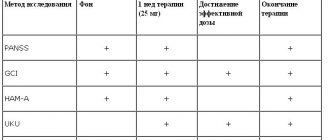Senesthopathy is characterized by various unpleasant sensations in the body. In this case, no objective pathological processes are observed. The sensations that a person experiences with senestopathy are completely devoid of objectivity. This is precisely their key difference from hallucinations.
Senesthopathy is not an independent disease! These symptoms always indicate that a person is developing a mental illness.
Treatment of senestopathy should begin with a detailed diagnosis. It is necessary to differentiate sensations from somatic disease and parasthesia. Hypersensitivity or unpleasant sensations can most often be observed in areas of the skin, muscles, and some organs.
Senestoalgia is a type of senestopathies characterized by more severe pain.
Senestopathic mental automatisms are a combination of senestopathies with the patient’s belief that painful sensations are the result of the influence of an outside force (“evil eye,” hypnosis, “telepathy,” electromagnetic waves, etc.).
Development of senestopathy
Senesthopathy always manifests itself against the background of the development of some mental disorder associated with a violation of the metabolic processes of the brain. To date, the mechanisms of development of senestopathy have not been fully studied. However, some patterns of development of these symptoms, biochemical and physiological changes in the functioning of the brain are well known to scientists and doctors. Based on them, recommendations are given for the treatment of such conditions.
It has been established that there are a number of diseases, including:
- organic pathology of the nervous system;
- toxic injuries, including alcohol or toxic poisoning, drug addiction;
- schizophrenia;
- senestopathy with neurosis.
The experience of senestopathy, according to modern scientific data, is explained by overexcitation of the midline structures of the brain with a disruption in the exchange of neurotransmitters in the nervous system.
How is senestopathy diagnosed?
Diagnosis and treatment of disorders occurring with senestopathies is carried out by a psychiatrist or psychotherapist. Senestopathy refers to the sphere of perception.
Perception is one of the highest mental functions of a person, which, if there are disturbances in the functioning of the central nervous system, can cause disturbances such as hallucinations, illusions, derealization, depersonalization and others.
Before starting treatment for senestopathy, it is necessary to carry out a differential diagnosis and ensure that the diagnosis is correct. Diagnosis of the disorder requires a complete history taking. It is necessary to analyze the patient's complaints in great detail, the results of additional media, if there is a suspicion of the possibility of somatic diseases. Additional tools can include hardware and laboratory techniques.
The disease must be differentiated from pain and sensations caused by somatic diseases and from paresthesia. Physical diseases of organs are characterized by a clear and constant arrangement of sensations, as well as a connection with the diseased organ and homogeneity of complaints.
Hypersensitivity can be observed in the Zakharyin-Ged zones. These are areas of the skin that reflect pain due to the pathology of internal wounds. Not only pain or increased sensitivity may be observed, but also an increase in local temperature, redness, etc.
Paresthesia - unlike senestopathies, is a neurological or vascular pathology.
- Neurological parasteria correspond to the area of innervation and are combined with other neurological symptoms.
- Circulatory disorders as a result of colds, increased load on muscles, etc., are accompanied by trophic symptoms and decreased pulse in peripheral vessels.
Causes of senestopathy
Modern medicine cannot yet confidently determine the causes of the development of senestopathy. Most psychiatrists believe that the disease is psychological in nature, but doctors are not yet completely sure of this.
Most often, senestopathies occur against the background of other mental illnesses - for example, against the background of schizophrenia, hysteria or MDP (manic-depressive psychosis). Often the cause of senesthopathy is either organic brain damage or neurosis (usually hypochondriacal). Moreover, senestopathy can become a source and factor in the development of hypochondria, causing unpleasant pain in different places of the body and not being localized in any one place.
Cases of independent senesthopathy cannot be excluded, but they are too rare and poorly studied to talk about them in detail.
Treatment of senestopathy
After differential diagnosis, it is necessary to establish the individual characteristics of the formation of the body and nervous system, the features of their interaction.
There are many options, methods and recommendations on how to treat senestopathy. In medicine today there is no consensus on this matter. A number of experts consider this disorder without taking into account its true nature and connection with other changes in the body. Therefore, you can find many different treatment options. Some, despite the undeniable nature of the disease, try to treat senestopathy psychotherapeutically, without medications. Which can only temporarily dampen the course and manifestation of symptoms.
However, the best way to get rid of senestopathy is complex therapy. It is prescribed in our clinic in the form of special, individually developed programs in accordance with the cause of the disorder and the characteristics of the patient’s body. Therapy using our methods is most effective in cases where the patient, due to the discomfort experienced, manifests depression and experiences a decrease in performance.
If the disease becomes chronic, we use special long-term programs that must be completed in stages. This is a modern technique that is recognized in Europe and is considered adequate to the human condition. As a rule, this is the only most effective way to get rid of the cause of such symptoms.
At the beginning of therapy, we use drugs that give the so-called “quick” result. In order to relieve acute manifestations and quickly restore the lost quality of life. In parallel, we use drugs that act on the disease more slowly, but are more effective in the future for the patient. Drugs are also used to restore, nourish and improve the functioning of the nervous system and the body as a whole.
If senestopathy is not treated
Unfortunately, most ordinary people believe that senestopathy can be cured on their own. However, this is a misconception that leads to serious mental health problems. The disease, thus, not only becomes more severe, but also becomes chronic. In such cases, treatment of senesthopathy becomes lengthy and more complex.
Most often, the problem can only be solved through the joint efforts of specialists of related specializations.
If you experience characteristic signs of senestopathy, do not despair and self-medicate! Come to the Transfiguration clinic, we can effectively help you!
Treatment of senestopathies
To get rid of unpleasant sensations, only drugs that provide therapy for the underlying disorder will help. The following medications are commonly used:
- antidepressants (treatment of depression);
- neuroleptics;
- tranquilizers;
- atypical antipsychotics;
- correctors for limb tremors.
Treatment of synestopathies at Dr. Isaev’s clinic is carried out using an individual approach to each person. Prescription of drugs is based on:
- medical history;
- the result of clinical and instrumental research;
- symptoms;
- duration of the violation;
- age;
- the presence of concomitant somatic diseases.
To obtain the desired result and relieve a person from suffering, a lot of time has to be spent. It is best to start therapy in a hospital, where the patient will be under the constant supervision of doctors. For patients with schizophrenia and other severe disorders, the clinic has a specially equipped psychiatric center. This way it is easier to select the necessary drugs to achieve stable remission. After which the patient can be transferred to outpatient treatment of senestopathies and the optimal maintenance dosage of medications.
In young working patients, atypical antipsychotics are the drugs of choice, as they are easy to use, have a minimal number of side effects and allow for full rehabilitation in the future. Drugs in this group relieve acute manifestations of psychosis and then prevent the development of relapse.
Antidepressants are usually prescribed serotonin reuptake inhibitors or tricyclics. They begin to act only after 1-2 weeks from the start of use and are used for 5-6 months with gradual withdrawal. In the first week, it is recommended to take them under the cover of tranquilizers, since a number of patients experience a temporary increase in depression.
Treatment of senestopathies with homeopathy or traditional medicine is strictly contraindicated. Self-medication is fraught with intensification of symptoms, their transition to a chronic course and the formation of resistance to necessary medications.
Forecast
Is there a danger to life with senestopathies? This question can be answered in the negative. In this condition, there is no threat to life or physical damage to the body. These conditions are dangerous only in that a person experiencing constant pain or some unpleasant sensations gradually becomes more irritable. Aggression begins to increase and his behavior changes frequently.
The progression of aggressive behavior in a sick person, especially over a long, debilitating course or with ineffective help, can provoke harm to both oneself and others. Life-threatening behavior is possible, and therefore, in these rare cases, emergency psychiatric care and possibly hospitalization with 24-hour close supervision may be required.
Diseases that provoke the occurrence of senestopathy
Below is a list of the most common diseases in which the symptom of senestopathy may appear.
- Organic lesions of the nervous system of any origin (vascular, atrophic, traumatic, toxic, infectious).
- Consequences of poisoning (including the consequences of alcoholism, drug addiction and substance abuse).
- Schizophrenia and so-called disorders schizophrenia spectrum.
- Affective disorders (bipolar affective disorder, depression, manic states).
- Neurotic disorders.
Depending on the content of the patient’s complaints, various types of disease are distinguished.
Types of senestopathy
- thermal sensations in the form of burning, cold or heat;
- bodily sensations, for example, a feeling of turning over, shifting, twisting, sticking together;
- movement of fluid in the body in the form of transfusion, clogging, pulsation;
- painful sensations - burning pain, tingling, drilling, squeezing, tearing;
- feeling of muscle tension, presence of a foreign body.
Types of symptoms
- Hallucinatory - sensations similar to hallucinations. Geometric, for example, in the stomach there is a ball from which pain comes with a projection onto the whole body. Tactile, the feeling of a blow to the body, someone pulling the hair, the head shaking on its own. Transformational, sensation that the brain is leaking or evaporating. May be accompanied by gustatory, visual, olfactory, and acoustic sensations. The difference from hallucinations is expressed in the relative nature of the descriptions (as, as if).
- Interpretative - rich in various interpretations, usually unusual. For example, complaints of a “freezing” brain “freezing”, “pain in the surface of the rib” or “itching” of the liver. Organotopic, associated and delusional senestopathies can be distinguished. Characterized by a false version, for example, “blood” does not enter the liver.”
- Elementary - destructive sensations that do not have a clear localization. For example, people suffering from manic-depressive disorder describe it as “constant internal stress,” which is difficult to describe.
- Simple - sensory. Pain, burning, etc. are projected onto the area corresponding to the patient’s sensitive area. Discomfort appears in any part of the body. Clear localization is not typical.
- Psychosensory senestopathy - sensations of changes in volume, size and orientation. For example, a feeling of a knotted stomach, fullness in the chest, pressure or squeezing in the head, twisting of joints, changes in the position or size of any part of the body.
Help from a psychotherapist
For mild deviations and in the initial stages, psychological methods of influence can be used to treat senestopathies. They are especially effective only after some relief of symptoms with drug therapy. For neuroses and unusual sensations, sessions with a psychotherapist are included in the mandatory program of comprehensive treatment. Most often, a specialist chooses the following methods:
- hypnosis;
- body-oriented psychotherapy;
- reconstructing positive thoughts;
- suggestion;
- learning ways to relax and switch attention.
Introduction to trance for senestopathy is rarely used, only if other methods are ineffective. Psychocorrection of a problem at the subconscious level using hypnosis is considered by experts as an aggressive influence. A gentle and effective method is body-oriented psychotherapy. The doctor helps the patient mentally move all organs and parts of the body to a zone of maximum comfort and well-being. This allows you to remove internal clamps and eliminate discomfort.
Positive thinking begins with a person’s concentration on the painful area, when he concentrates as much as possible and, with the help of aromatherapy or pleasant music, frees himself from his problem. In highly suggestible patients with mental disorders, it helps to gradually convince them that their fears are pointless and that there is no danger of developing a serious illness. This treatment of anxiety, neurosis, hypochondria and unusual sensations is considered the most effective.
An integrated approach and successful treatment of mental disorders at Dr. Isaev’s clinic allows you to get a positive result in the shortest possible time. After therapy, many patients return to their families, to their place of work and can live a full life, no different from others. The most important thing is to seek help as quickly as possible.
How does senestopathy manifest?
People often experience sensations that they cannot describe, but bring severe discomfort. In this case, there is no sensation of pain. Most often they are localized in the head and neck, less often in the chest and abdomen; people least of all complain about manifestations in the limbs and genitals.
As a rule, sensations can often “migrate”, but are often clearly localized, but the nature of the described feelings remains uncharacteristic of somatic pathology. Depending on the characteristics of the attack, the syndrome is divided into permanent or episodic senestopathy.
Very often it manifests itself unexpectedly and paroxysmally - senestopathic crisis. Almost always, an attack of senestopathy is accompanied by autonomic dysfunction with a panic reaction and even epileptic seizures.
At the appointment, patients describe a wide variety of sensations, often fanciful, and often the person himself does not believe in the possibility of their real existence. But they all reduce the quality, since they interfere with concentration on the actions being performed and concentrate their attention on them. However, the clinical manifestations are not typical for diseases of the internal organs, skin or musculoskeletal system.
There are complaints of sensations of leakage or decomposition of the brain or other organ. The sensations are often far beyond normal sensitivity. Some people find physical pain much easier to bear than the feelings they describe.
At the beginning of the formation of the disease, simple senestopathies occur, which are close to complaints about somatic diseases. As the sensations develop, they gradually acquire a more complex, often elaborate and confusing character with unnatural localization.
Help with senestopathies
Most diseases that occur with senestopathies require drug treatment, since only with the help of medications can it be possible to reduce the severity of overexcitation of those foci in the nervous system that are responsible for senestopathic phenomena.
Of the most effective and frequently used drugs, the following groups are used: antipsychotics, antidepressants, mood stabilizers, neurometabolic therapy.
It should be especially noted that taking painkillers has no effect on manifestations of senestopathy. Some experts note the effectiveness of certain psychotherapeutic methods for senestopathies: EMDR (parallel eye movement desensitization), TOPT (body-image psychotherapy), hypnosis, but they also note their effectiveness against the background of concomitant drug treatment.
In conclusion, we note something important: senestopathies are a symptom of a nervous system disorder, a sign of a disease that always requires qualified help. If you have signs of this condition, do not delay visiting a psychiatrist or psychotherapist.
The Brain Clinic diagnoses and treats all types of diseases accompanied by senestopathies.
Symptoms of senestopathy
Since the symptoms of senestopathy can only be determined from the words of patients, most of whom have other psychiatric diagnoses, determining the range of symptoms is extremely difficult. In addition, the disease manifests itself differently in each patient - some have a stabbing pain in their backs, others feel as if their internal organs are bursting, others complain of itching or chills. There are many different manifestations of senestopathy known, but, again, it is impossible to determine which of them are related to reality and which are inventions of patients.
There are times when the patient cannot explain at all what is happening to him, which is why he feels terrible. At the same time, he does not complain of any pain and does not react to physical influences.
What does senestopathy consist of? According to scientists, synestopathies have the following symptoms. They:
- Hallucinatory;
- Obsessive;
- Affective;
- Interpretive;
- Depersonalization.
The main clinical manifestations of senestopathy are:
- polymorphism;
- difficult formulation of the complaint by the patient;
- painful and painful tone of sensations;
- blurred localization of sensations;
- annoying nature of the manifestation;
- atypical projection. That is, the imaginary sensations of receptors located outside are transmitted to the zone where the brain perceives the work of internal organs.










